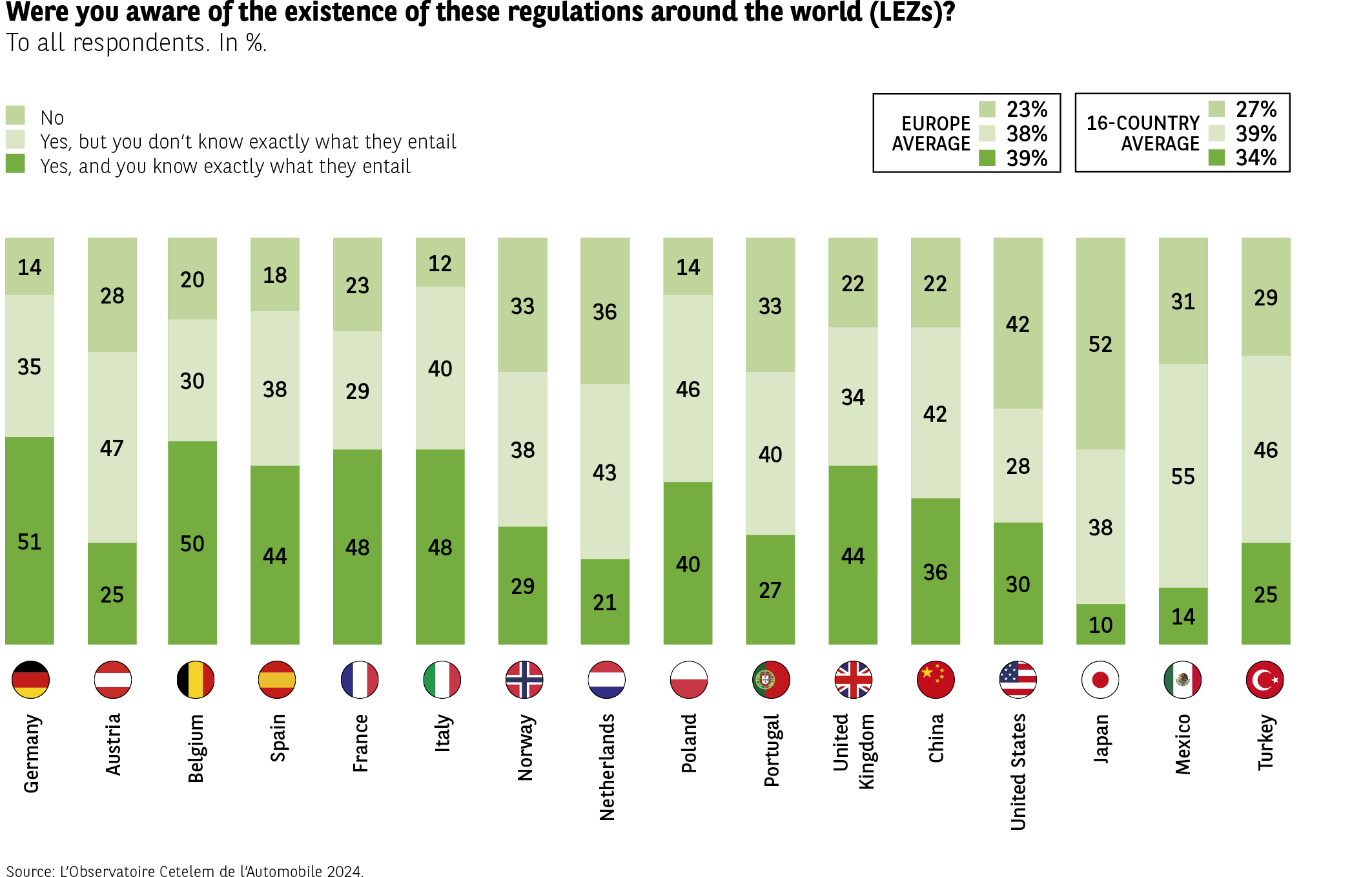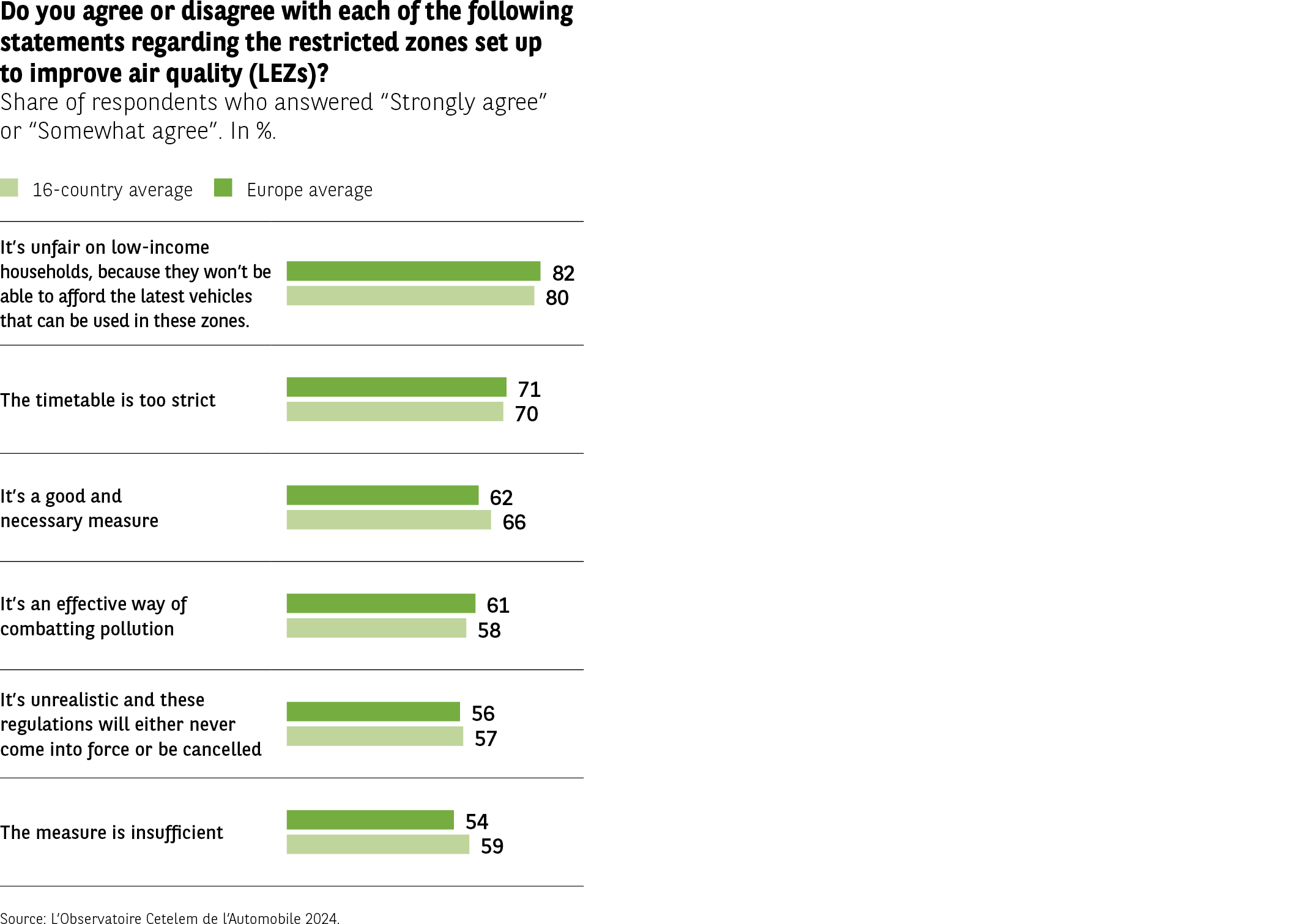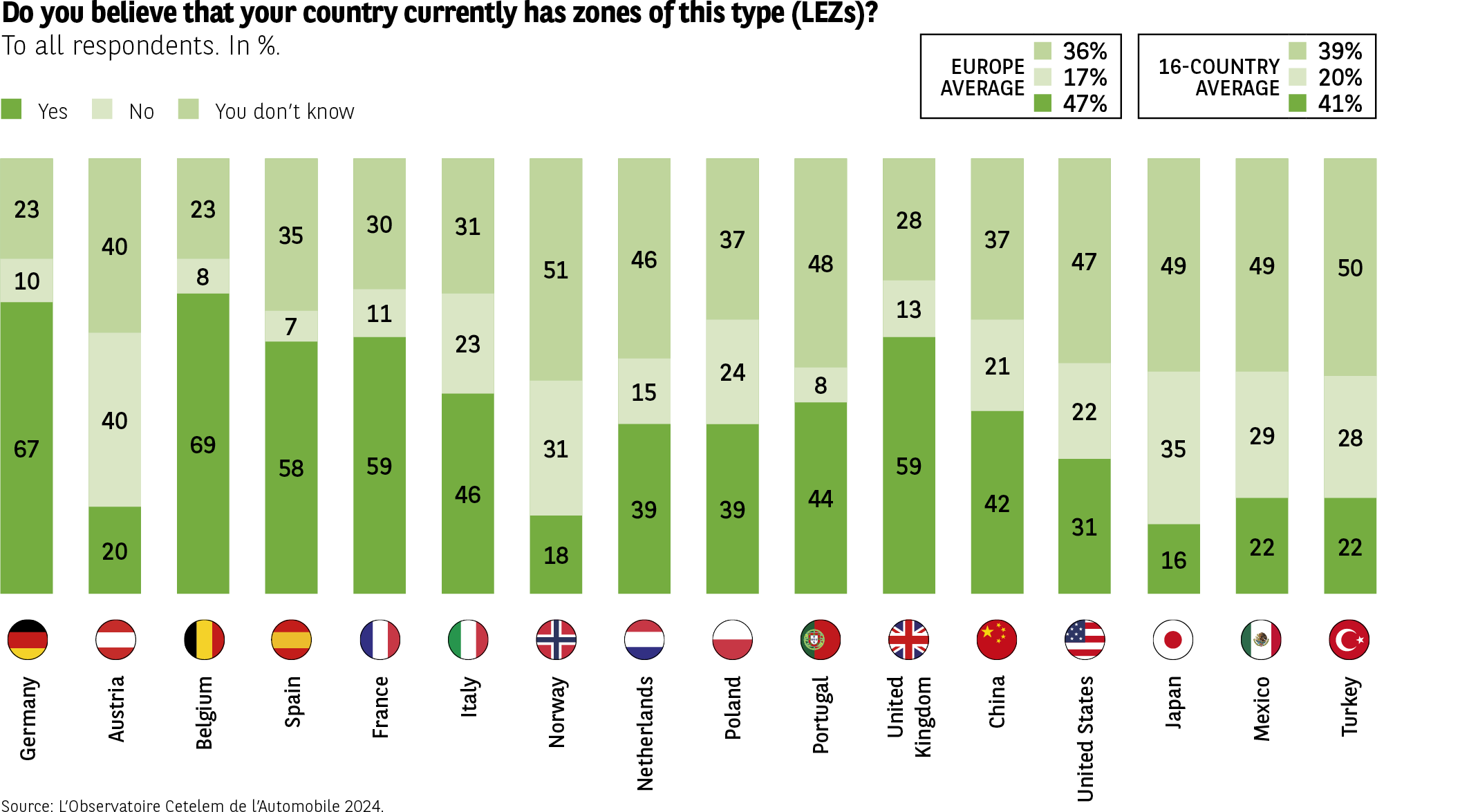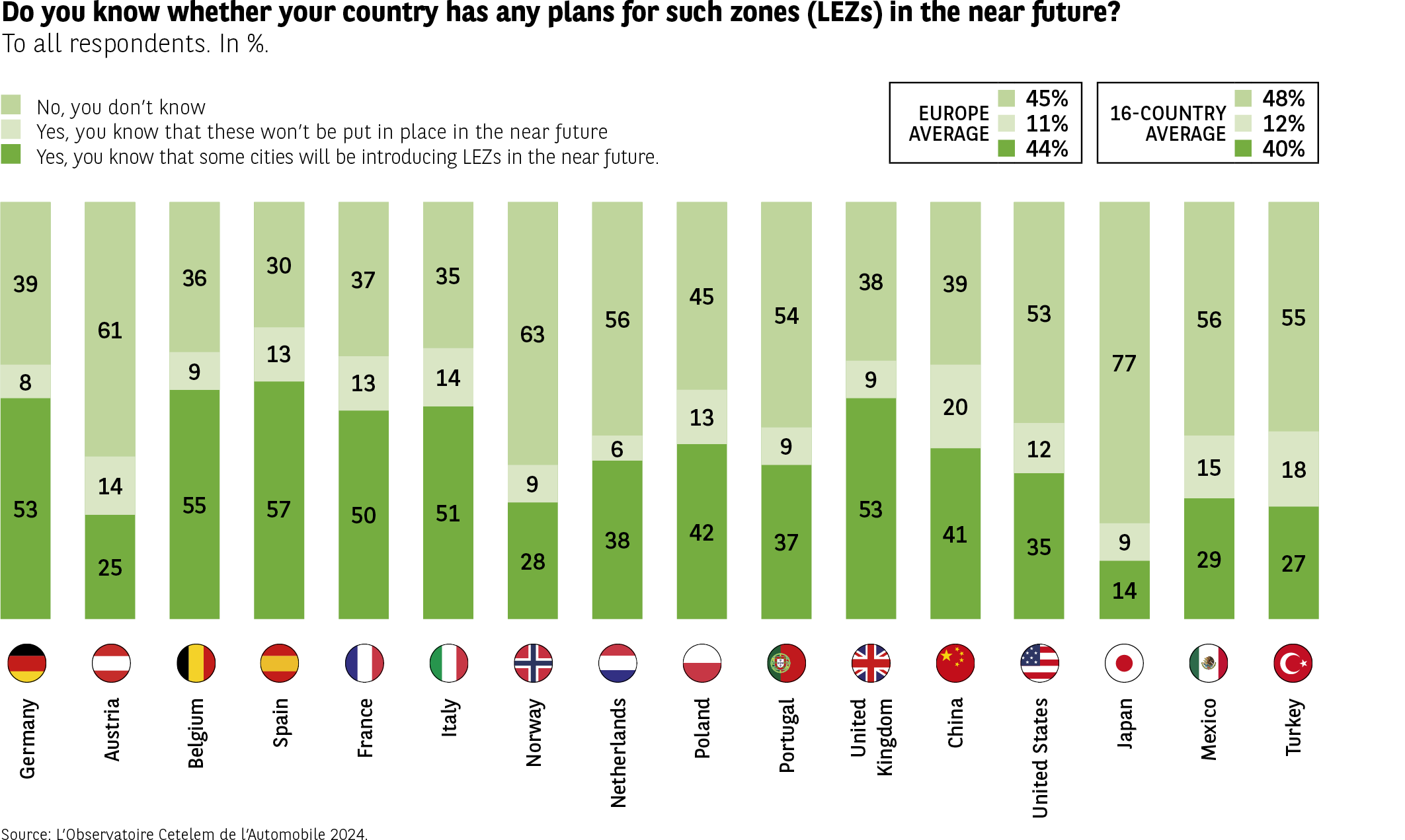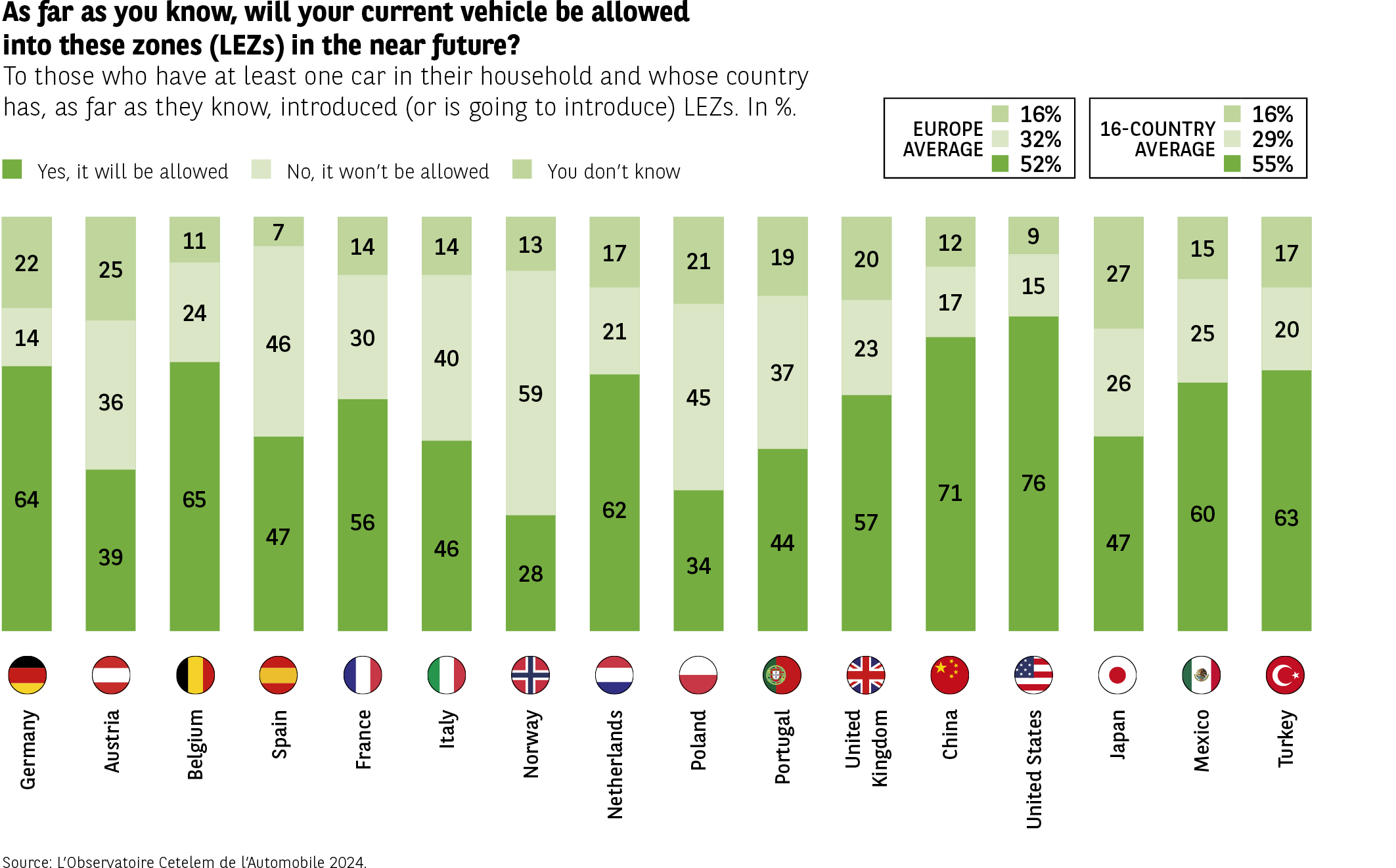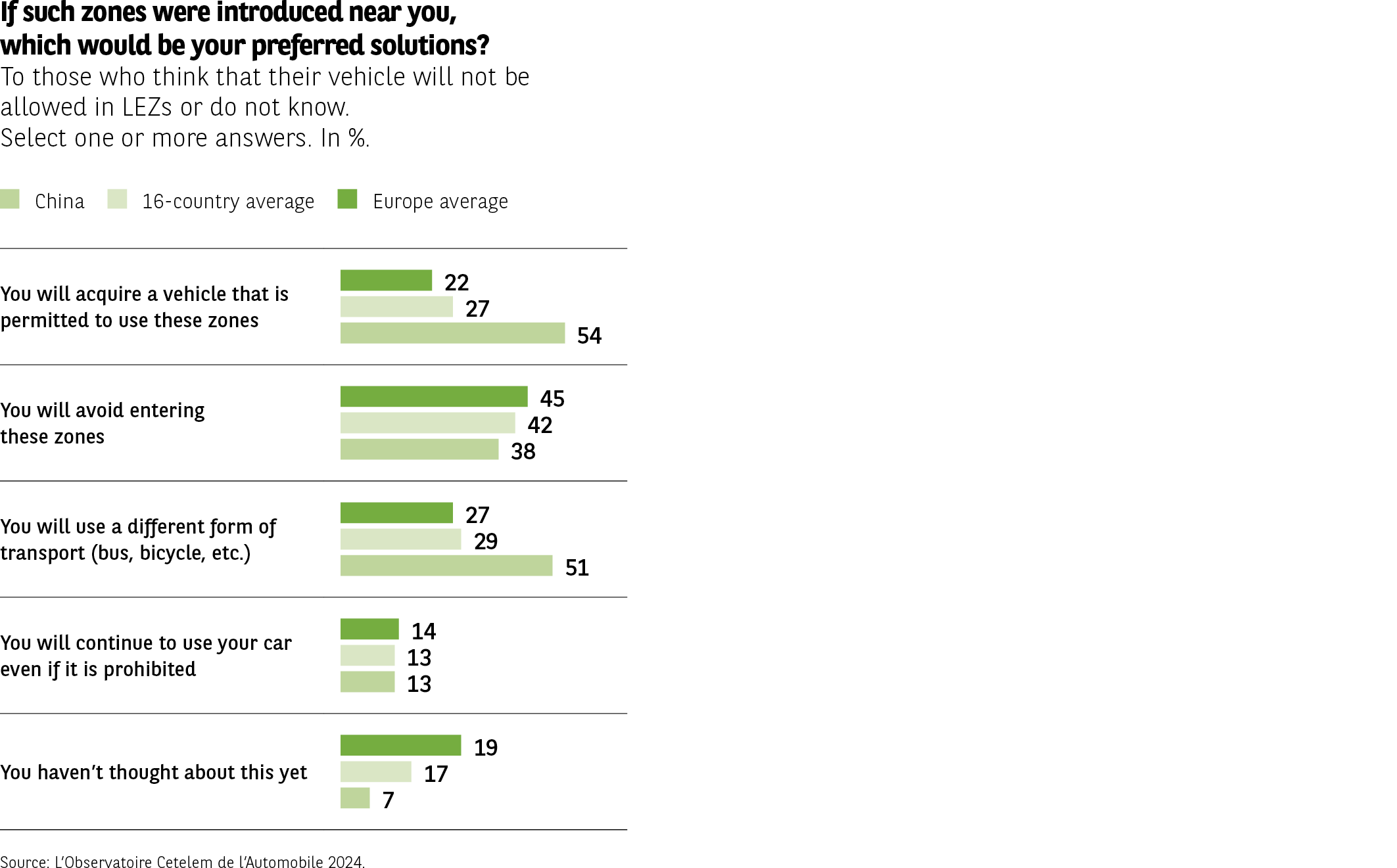LEZs: an overarching sense of injustice
INFORMATION IS OFTEN POORLY UNDERSTOOD
Indeed, the reality of people’s level of understanding is more complex and offers contrasting lessons when studied in detail.
On the subject of LEZs, while more than 7 out of 10 people are aware of their existence, only a third know exactly what they are. That’s almost the same as the proportion of people who are completely ignorant of their meaning. This split into three almost equal blocs underlines the uncertainty that surrounds these regulations, with their shifting names and definitions. LEZ is a term full of significance… but what does it actually mean? Well, that’s precisely the problem.
An examination of the geographical breakdown of the opinions gathered reveals a relative reversal of the trends that had prevailed up until now.
Today, most of the European countries surveyed, particularly those where LEZs are in place, rank highly when it comes to the proportion of motorists with specific awareness of their existence. This is particularly true for Germany, Belgium, Italy and France, which post scores of 50% or close to it. Meanwhile, in Mexico and Turkey (which are not affected by these measures), but also in the Netherlands and Austria, the level of knowledge regarding LEZs is low. For instance, only 14% of Mexicans claim to understand what they entail.
Once again, Japan stands out. Only 10% of Japanese respondents have precise knowledge of these zones, while more than half plead complete ignorance, making them the only population for which this is the case (Fig. 8).
NEGATIVE RESPONSES
However, an individual’s relative familiarity with LEZs does not mean that they will agree with them in practice.
It is true that 66% of those surveyed believe them to be a positive measure. But the countries in which LEZs are widespread and have been established the longest are home to the highest proportion of naysayers, which include more than half of French and Belgian respondents. Conversely, almost half of the Turks and Mexicans surveyed strongly agree with the concept, whereas the smallest proportion of individuals who have a clear opinion on the topic can also be found in Turkey and Mexico, a sign of the level of interest in these measures in two countries where LEZs do not yet exist.
So, are these measures viewed positively? Not especially, if we are to believe a set of results that cast LEZs in a highly negative light and reflect suspicion, if not a complete rejection. First and foremost, 8 out of 10 people consider such measures to be unfair to low-income households, once again underlining the importance of financial aspects when it comes to motoring. As if to echo the Yellow Vests crisis, which was born out of a political decision that affected people’s cars and wallets alike, the French are the most likely to condemn the financial impact of LEZs (85%).
The second biggest source of criticism is the speed with which such measures are implemented. 7 out of 10 people feel that the timetable is too strict. On this topic, the Belgians and the French are the most critical.
Paradoxically, while LEZs are considered fair from a conceptual perspective, they are also deemed insufficient. Once again, we find the Turks at the top of the ranking (85%), followed most closely by the Chinese and Italians. In the neighbouring countries of the Netherlands and Belgium, this opinion is only half as common.
The measures are considered insufficient and therefore ineffective in fighting pollution. Nearly 6 out of 10 people are of this belief. Once again, the European countries surveyed, led by Germany and France, stand as one in sharing this opinion, while China and Japan are also united for once, with a majority believing that LEZs are effective.
Finally, almost 6 out of 10 people go as far as to say that LEZs are unrealistic and that they hope they will never see the light of day. This is a viewpoint held by a majority of respondents in all countries, even those in which they have been a reality for some time now (Fig. 9).
LEZS, A MATTER FOR THE PRESENT OR THE FUTURE?
But do motorists think that these LEZs actually exist? Here again, motorists are slightly mystified. Only 4 out of 10 respondents say that they are in place in their country. But a sense of reason prevails. The highest scores can be observed in Germany, Belgium, the United Kingdom and France, all of which have introduced LEZs or are planning to do so. And where do negative answers account for the majority? In Japan, of course (Fig. 10).
Things are even more opaque when it comes to predicting the future. 1 in 2 motorists do not know whether LEZs will be put in place in their country. In half the countries surveyed, the proportion of people who admit that they do not know actually exceeds 50%, with the Norwegians, the Austrians and, once more, the Japanese pleading ignorance regarding future LEZs. Much like previously, the more established European countries are home to the highest proportions of respondents who state that the future of LEZs is written (Fig. 11).
Both of these points only serve to highlight the genuine scepticism of motorists, who sometimes flirt with reality denial by refusing to believe in the possibility of implementing measures that are already in place in their country. Alternatively, this could be viewed as a blinkered and selfish stance: “they don’t exist because they don’t affect me”.
DRIVING IN LEZS IS POSSIBLE
Whether or not LEZs are in place, a narrow majority of respondents (55%) are confident that their vehicle will be able to enter these zones. But on this topic, the blocs of opinion formed previously fragment. For once, China and the USA are united in stating this most confidently, followed by Belgium and Germany
Surprisingly, in the highly electrified country of Norway, 6 out of 10 respondents believe that their vehicle will be excluded from LEZs. This score is head and shoulders above the rest. More astonishing still, 10% of those who own an electric vehicle do not know whether they will be able to drive it in LEZs (Fig. 12).
A CAPACITY TO ADAPT
Faced with the possibility that they will not be able to drive in these zones, motorists are organising themselves in a very pragmatic and flexible way.
In China, the emphasis is on finding strategies to avoid or bypass LEZs, both literally and figuratively. More than 1 in 2 Chinese respondents would buy an authorised vehicle or switch to soft mobility. On average, around 30% of those surveyed are in favour of these two solutions. The Turks and Mexicans, and to a lesser extent the Italians, also favour the former. The latter is most popular in Mexico, but also in Japan. Both options are preferred by a majority of women and seniors.
The French spirit of opposition (and resistance) is alive and well. 1 in 2 will continue to drive their banned vehicle in LEZs. This rebellious attitude is shared
by the Germans. It should also be noted that only a quarter of those surveyed would consider replacing their vehicle (Fig.13).
Its dimensions are gargantuan: 4.90 m long, 1.93 m wide, over 2 m high. Its 6-cylinder engine produces 285 bhp in its petrol version and 249 bhp in its diesel version. It consumes 14 litres of fuel per 100 km and emits 336 grams of CO2 per kilometre. And yet it will be able to enter France’s LEZs, with a Crit’Air 1 sticker for the petrol version and a Crit’Air 2 sticker for the diesel. We are talking about the Ineos Grenadier 4×4.

